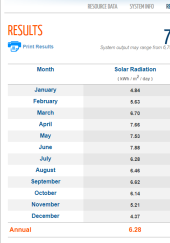Yes, that is exactly the question. I am conversant in ohms law but solar mathi is a little less tangible and the information is fuzzy. It says my location has 4.5 hours of sun. Does that mean daily average? Does it mean i'll only get the rated wattage for 4.5 hours on a sunny day in august? How much will output reduce in the remaining hours of daylight?
It means you multiply your solar array power by 4.5h to get kWh. This assumes the panels are oriented due south and at an optimal tilt with zero shading from sunrise to sunset.
It is likely an average annual value. Link #1 in my signature references two sites that will give you monthly breakdown by hour.
Example of my system's location in AZ using the PVWatts link:

But days without sun require a lot less AC.
Not sure about you, but I've been in some pretty hot weather when the sun was behind clouds. Still need A/C.
Which segues to another question, how mush does output diminish under various cloud conditions?
You're catching on. Panel almost never put outs rated power even in perfect sun. The sun hitting the panels increases their temperature. The increased temperature lowers their operating voltage. Since power is Volts * Amps, the power is less. Many panels have a NOCT rating that is more "real world," and you should use those values for any expectation for what the sun can power.
The PVWatt site takes into account your average weather conditions. You can download hourly data into a CSV file and look at the actual day to day variation.
You either use general guidelines for system design, or you gather a year's worth of data, design accordingly and hope that every year is like the last.
Planning helps avoid two things:
1) An under-spec system that fails to meet your needs.
2) An over-spec system that costs way more than you needed.



